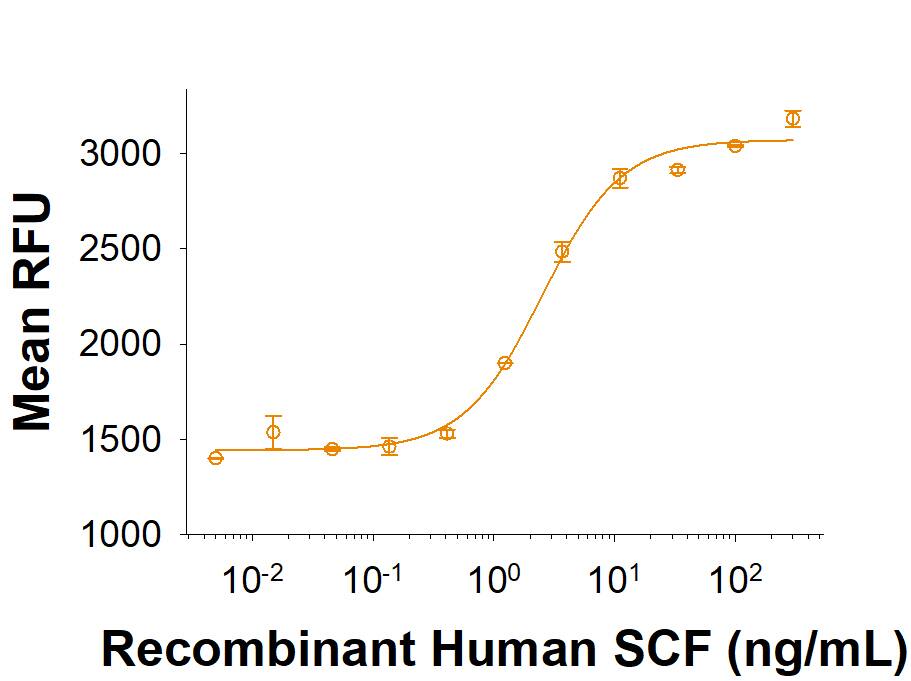Recombinant Human SCF (Mammalian-expressed) Protein
R&D Systems, part of Bio-Techne | Catalog # 7466-SC


Discontinued Product
7466-SC has been discontinued.
An alternative/replacement product is available:
11010-SC. View all SCF/c-kit Ligand products.
Key Product Details
Product Specifications
Source
Human embryonic kidney cell, HEK293-derived human SCF/c-kit Ligand protein
Glu26-Ala189
Glu26-Ala189
Purity
>95%, by SDS-PAGE visualized with Silver Staining and quantitative densitometry by Coomassie® Blue Staining.
Endotoxin Level
<0.10 EU per 1 μg of the protein by the LAL method.
N-terminal Sequence Analysis
Glu26
Predicted Molecular Mass
18.5 kDa (monomer)
SDS-PAGE
24-30 kDa, reducing conditions
Activity
Measured in a cell proliferation assay using TF-1 human erythroleukemic cells. Kitamura, T. et al. (1989) J. Cell Physiol. 140:323.
The ED50 for this effect is 1-5 ng/mL.
The ED50 for this effect is 1-5 ng/mL.
Scientific Data Images for Recombinant Human SCF (Mammalian-expressed) Protein
Recombinant Human SCF (Mammalian-expressed) Protein Bioactivity
Measured in a cell proliferation assay using TF‑1 human erythroleukemic cells. The ED50 for this effect is 1-5 ng/mL.Formulation, Preparation and Storage
7466-SC
| Formulation | Lyophilized from a 0.2 μm filtered solution in PBS with BSA as a carrier protein. |
| Reconstitution | Reconstitute at 100 μg/mL in PBS containing at least 0.1% human or bovine serum albumin. |
| Shipping | The product is shipped at ambient temperature. Upon receipt, store it immediately at the temperature recommended below. |
| Stability & Storage | Use a manual defrost freezer and avoid repeated freeze-thaw cycles.
|
Background: SCF/c-kit Ligand
References
- Ashman, L.K., 1999, Int. J. Biochem. Cell Biol. 31:1037.
- Sette, C. et al., 2000, Int. J. Dev. Biol. 44:599.
- Yoshida, H. et al., 2001, J. Invest. Dermatol. Symp. Proc. 6:1.
- Erlandsson, A. et al., 2004, Exp. Cell Res. 301:201.
- Kapur, R. et al., 2002, Blood 100:1287.
- Wang, C.-H. et al., 2007, Arterioscler. Thromb. Vasc. Biol. 27:540.
- Bashamboo, A. et al., 2006, J. Cell Sci. 119:3039.
- Reber, L. et al., 2006, Eur. J. Pharmacol. 533:327.
- Martin, F.H. et al., 1990, Cell 63:203.
- Arakawa, T. et al., 1991, J. Biol. Chem. 266:18942.
- Majumdar, M.K. et al., 1994, J. Biol. Chem. 269:1237.
- Brannan, C.I. et al., 1991, Proc. Natl. Acad. Sci. USA 88:4671.
- 13. Anderson, D.M. et al., 1991, Cell Growth Differ. 2:373.
- 14. Lemmon, M.A. et al., 1997, J. Biol. Chem. 272:6311.
- 15. Kanellakis, P. et al., 2006, Cardiovasc. Res. 70:117.
Long Name
Stem Cell Factor
Alternate Names
c-kit Ligand, DCUA, DFNA69, FPH2, FPHH, KITLG, KL-1, MGF, SHEP7, SLF
Gene Symbol
KITLG
UniProt
Additional SCF/c-kit Ligand Products
Product Documents for Recombinant Human SCF (Mammalian-expressed) Protein
Product Specific Notices for Recombinant Human SCF (Mammalian-expressed) Protein
For research use only
